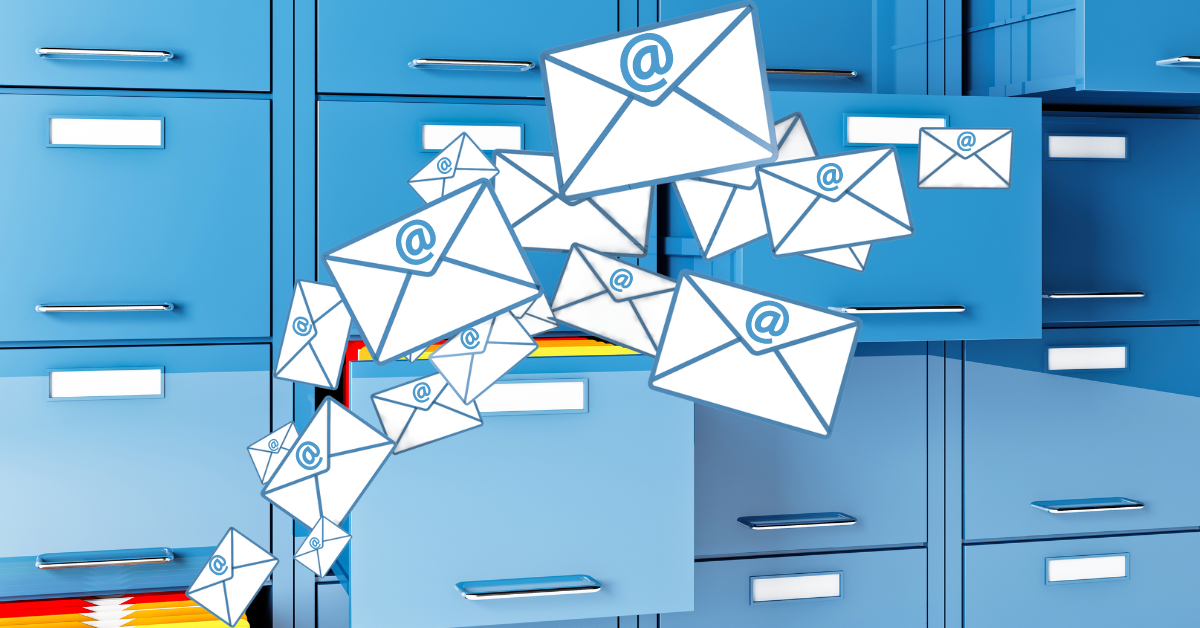Last Updated on February 5, 2024 Sarah Gayda
In today’s fast-paced business environment, email has emerged as the most prevalent form of communication. It’s integral to everyday operations and strategic decision-making. And despite what many of you hoped, it’s not going away any time soon:)
As a result, understanding and implementing effective email retention strategies have never been more crucial. But what is email retention, and why is it so important for organizations today? And what are some email retention policy best practices? Let’s dive in.
The basics of email retention
Email retention refers to the process of retaining emails as records within your organization. This is based on the policies and retention requirements set by governing or regulatory bodies. This involves determining the length of time that emails should be retained or archived before being permanently deleted.
In North America, most federal and state laws stipulate that emails must be retained for a period of between 3 and 7 years. However, certain types of data may need to be retained indefinitely. This depends on the nature of the information and the regulations governing its storage.
In addition to regulatory and legal reasons for keeping email, business efficiency is another motivation. If email is easily retrieved or surfaced again through search, this saves time and provides business value.
In fact, in a recent Colligo webinar poll, 52.5% participants claimed business efficiency was their top reason for retaining email, followed by regulatory/compliance and legal protection.

Why is dealing with email retention so daunting?
Despite the clear benefits, managing email retention can be a daunting task. The sheer volume of emails that organizations deal with on a daily basis can make it challenging to manually sort and retain necessary communications.
In our recent webinar – How to Rock Email Retention in Exchange Online & Microsoft 365 – we discuss these challenges in more detail. We talk about why Outlook is not an effective or compliant storage repository and identify three common categories or types of organization:
- Retainers – Keep everything automatically (addresses compliance risks, but retrievability, or finding emails again, can be problematic)
- Purgers – Short retention window & auto-delete (minimize over-discovery risks, might impact the business)
- Passives – Let employees do as they will (highest risk)
Now there are pros and cons to the above three strategies. Look no farther than the recent $4M fine given to JPMorgan Chase to understand the risk of over purging.
Does your organization fall into one of the above categories? Then, it’s probably time to develop a proper retention policy as part of your email management program.
The importance of email retention policies
The significance of email retention cannot be overstated. It helps your business protect sensitive information and meet legal requirements. It also ensures your organization follows all regulatory compliance. This reduces the cost of fines for non-compliance and the risk of sanctions.
Implementing a robust email retention policy also improves the performance of your IT systems without escalating costs. It enables your organization to efficiently and quickly impose a legal hold in the event of litigation or audits and speeds up email ediscovery.
Email record retention policy best practices
To help you get started, we’ve come up with some general email retention best practices for developing an Outlook retention policy at your organization:
- Establish a regulatory retention schedule – Research and document the email retention laws applicable to your region and industry. Your retention schedule should cover these.
- Determine an internal retention schedule – Beyond these legal requirements, determine what retention schedule makes sense for your business for different classes of documents. In other words, what types of documents should you keep beyond the legal minimum? In this case you would consider all documents in your organization, not just emails.
- Determine disposition type and schedule – Based on the first two schedules, you should dispose of ROT (redundant, outdated, trivial) emails/documents as soon as their legal retention period has elapsed. For the records and high-value emails and documents, your disposition schedule will be based on a time, or pending a review, or based on a time following an event (e.g., time following a product discontinuation date or employee termination date).
- Consolidate policies – Simplify and combine schedules to limit the number of retention categories you require. If you can get down to a few dozen at most, that is ideal. Consider how to combine retention policies on containers and retention policies attached to items (retention labels) to cover the full lifecyle of documents.
- Create rules in Microsoft Purview in test – Deploy and monitor the retention rules in Purview before turning them on to ensure you have it right.
How Colligo Email Manager can make your life easier
Clearly, email retention is a balancing act between retaining emails for business or legal reasons and removing unnecessary ones to optimize storage. And this is where tools like Colligo step in.
Regardless of whether you have a formal email retention policy in place or not, Email Manager can help you effectively move emails and attachments to SharePoint, making crucial business information searchable and shareable.
Even better, our new bulk filing tool allows you to migrate, copy, or move large quantities of emails and attachments (or folders and sub-folders) from Outlook to SharePoint on an automated schedule.
Colligo also automates the application of metadata or labels to emails, ensuring they align with your organization’s compliance objectives. In other words, we ensure that your important data is accessible when needed. At the same time, we reduce the risk and cost associated with managing vast amounts of data.
Email retention done well means greater compliance & productivity
In today’s world, data breaches and compliance failures can have significant financial and reputational implications. A well-thought out and implemented email retention plan is no longer a luxury but a necessity. By understanding what email retention is and implementing a strong policy, your organization gain protection while improving operational efficiency.
Remember, we’re here to assist you with all things information management. Don’t hesitate to reach out if you need help navigating the complexities of email retention. With the right tools at your disposal, you can transform this challenge into an opportunity for enhanced productivity and compliance.


